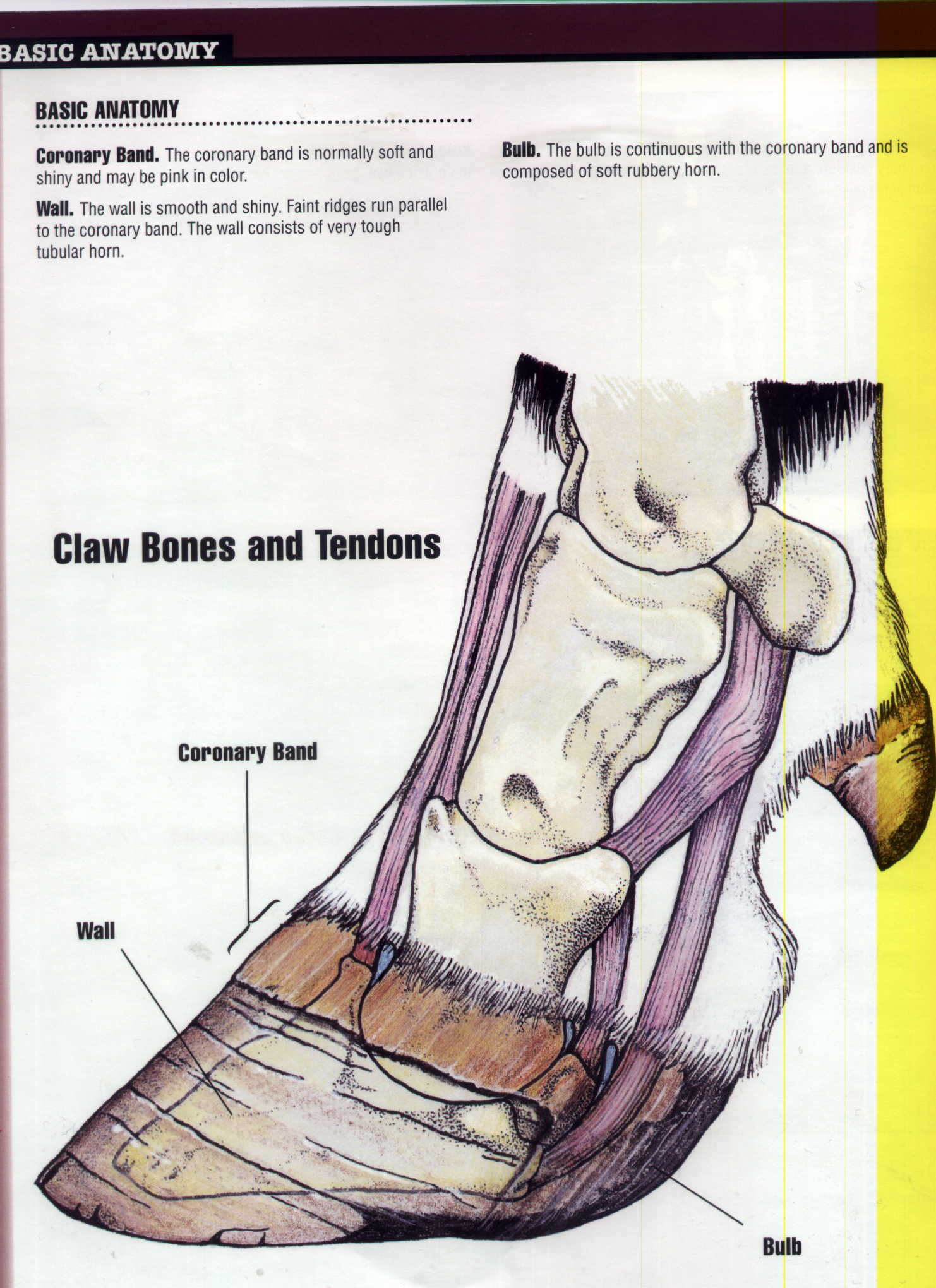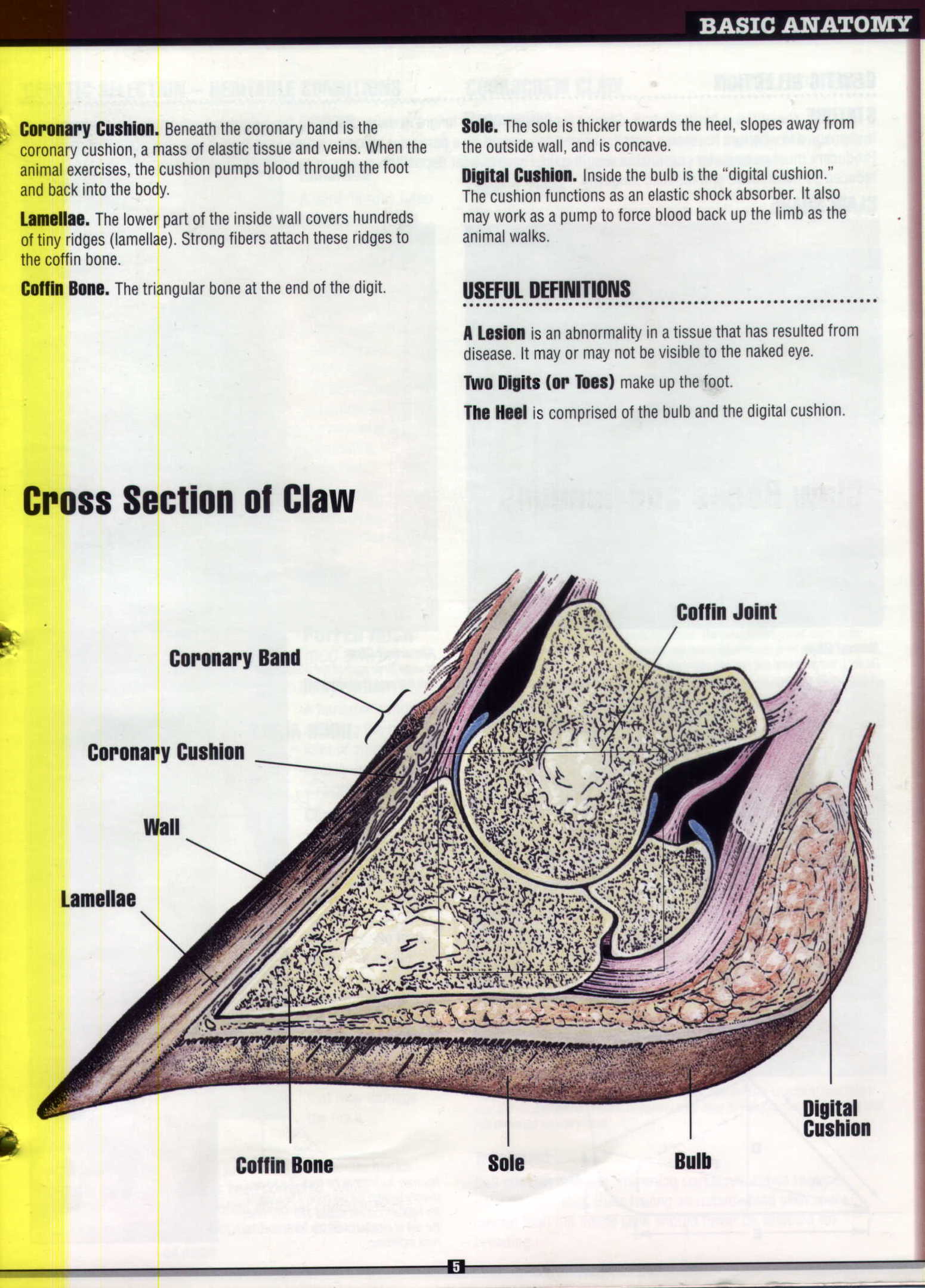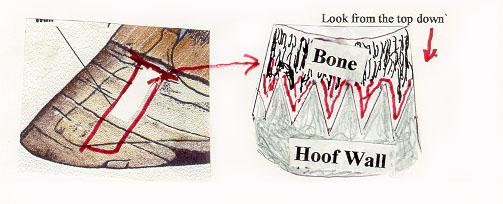

A Study of How the Hoof of the Cow is Designed
Study notes from Dr. Bob Scott D.V.M.
If you purchase an automobile or a machine of any sort and expect to care for it properly you are very likely to get an owners manual.
When we talk about the hoof health of the cow the same exact requirements will also apply to all hooved animals so it really doesn’t matter if your livestock is cows, sheep, horses or pigs the same sort of good animal husbandry practices is the way to better production.
The importance of keeping the hooves in the proper shape and length is vital to the performance of the animal.
The Roman armies were victorious partly because the Romans were able to put horseshoes of iron on their horse’s hooves and thus get longer mileage without sore feet.
So the understanding of the importance of the hoof is thousands of years old and unfortunately we have in some herds forgotten that in order for the cow to produce the huge quantities of milk we expect she must have good feet.
If the feet hurt when the animal walks the food intake is diminished. But I have been on farms where the owner has spent a lot of time and attention for the machinery to deliver a beautifully mixed ration to the feed bunk.
But has neglected to be sure the quality of the protein in that ration is designed to build good strong feet. If the feet are not furnished the good building blocks for hoof manufacture through the blood and hoof wall is poor quality we have problems.
We know if we don’t have adequate tire strength on our vehicles and overload them then we have flat tires.
I am going to show you a flat hoof and I know this poor cow had excessive NPN in her diet.. NPN stands for Non Protein Nitrogen and can be either nitrates in either the feed or the water or more urea in the ration than she could easily convert into quality protein.
The way ruminants convert urea into quality protein is called UFP or Urea Fermentation Potential.
When you add urea without proper ration balancing and do not understand that unless you have adequate energy to make the UFP work as it should you are poisoning your animals and will ultimately destroy their health.
The next pages will give you some pictures to study and then we will follow with some more explanation of how the hoof is attached to the coffin bone and why laminitis is such a problem.
Begin all study of lameness by understanding how the foot is built. The coronary band in this picture
Is where the germinal epithelium cells build new hoof just like you grow a fingernail..

Notice how the hoof encloses the coffin bone and is designed to carry the weight safely.

When we cut the leg so you can see the center of the leg it is a little easier to get an idea of how the tendons will flex and extend the toe as the animal walks. Again notice the junction of the hide and the hoof wall at the coronary band which is where new good hoof growth takes place. It is only good if the quality of the protein is good. We must understand that diet influences protein quality in the blood.
How is the hoof held onto the Coffin Bone?
This is probably the most informative and important page in this entire story because it will allow you to understand 3 things. 1) How the hoof can continue to grow downward even though it is firmly attached. 2 Why founder makes them lame and unable to walk off. 3) Why acidosis from a change in diet can make them sick and off feed.
I have taken a slice out of the hoof as you can see and then moved it to the right side of the page and turned it so you can look down and see the accordion like laminae that hold the hoof to the bone.
If you ever hit your finger with a hammer or pinched it in a car door you know there is a very painful blood spot that appears almost instantly. Because the joint between the hoof wall and the bone is filled with millions of very small capillaries full of blood to nourish the hoof and coffin bone.

The Laminae are separated from the bone by a huge network of connective tissue and capillaries. This allows the hoof to grow downward and it is connected with a cushion of blood vessels between the bone and hoof.
It also acts to push the blood back into the veins and toward the heart with every step the animal makes. There is a venous pressure because of this action and the one-way valves keep the blood moving on it’s way back to the heart.
The word lamina in Latin means wall. When the Laminae are inflamed we call it laminitis and the animal hurts when it walks.
Laminitis also produces a change that can be clearly seen as the hoof grows out and it will be a concentric ring around the circumference of the hoof until it wears out.
Causes of Lameness
The body has precise instructions for it’s growth, maintenance and repair.
Each cell has a copy of the instructions and it is called the DNA molecule
There are all sorts of cells in the body and because of the instructions some are destined to be built to function as a part of a system. The cells that comprise the lung tissue are distinctly different from the cells that make the hide even though they are connected where the nostrils connect to the nasal passages.
The skin or hide has a similar association with the hair; fingernails or hooves and the horn are all cells that begin as specialized cells called germinal epithelium. They are a part of the skin but have become specialized so that their growth is to become hoof for the purpose of this article.
All cells in the body derive their nutrients from the blood. Any portion if the nutrient had to come from the diet.
When the supplies arrive at the germinal epithelium for the manufacture of hoof the process begins. There are limitations of course on what the factory of the germinal epithelium must use but when the exact raw materials do not arrive the instructions from the growth and repair orders prevail and the hoof is constructed with the supplies that are available.
You have probably noticed that yourself in your own fingernail growth. Sometimes a doctor or nutritionist will suggest certain dietary supplements and you will discover that your nails seem to be stronger and grow better. The reason is of course that you got the proper ingredients in the diet to promote normal nail growth.
If we accept this premise then these are some of the ingredients that must be present in the diet.
Minerals
Because the hoof must be designed to be strong, elastic and capable of resisting abrasion and yet capable of wearing off to make room for new growth that is a continuous process. The same combination of minerals that make bone are needed in the hoof.
Protein
We accept the fact that the proteins in the body are the building blocks. Here again the body must produce according to the supply given by the blood stream. The materials in the blood came from the diet. The proper blends of minerals are needed to insure the kind of hoof that will wear off with usage.
The real hazard with today’s diets is the fact that too many of the diets contain a product called urea. Or the diet may have too many nitrates. Body tissues that are built with what I like to call junk protein that results from too much NPN. In either case the proteins the body must attempt to build with poor supply results in an inferior grade hoof material if that is the area of study.
The quality of the protein depends upon the diet. To much NPN, non – protein – nitrogen is not really a deadly poison but the damage or impairment to the body can result in all sorts of abnormal tissue or tissues that are incapable of performing properly.
Hooves that exhibit a more flexible type hoof wall that does not wear off properly often will continue to grow so the animal is bearing weight on the sole of the foot more than the edge of the hoof wall.
To get an idea of the structure that needs to bear the weight visualize a horseshoe.
The cloven hooved animal sheep, cows, antelope, deer or those that have two feet still are designed to bear weight on the hoof wall. The hoof material between the toes is never designed to bear weight and should wear off more quickly than the outer edge hoof wall.
Hooves that do wear properly need a hoof trimmer or the abnormal wear will ultimately cause lameness because the hooves will lose their correct shape for effective weight bearing function.
Diets that produce acidosis influence hoof growth
Most animal husbandry people have heard the term, founder. A belly ache that produces sore feet is an ailment that can affect all cloven hooved animals. There can be differences but this is the basic set of events in the order of they way the disease progresses.
The pH of the normal rumen is alkaline. When high energy foods, like wheat for example are fed to excess, there is a sudden release of dextrose in the rumen and microbes that utilize the quick release of that dextrose or energy immediately grab it and process it.
Again most farmers are aware of this reaction. In fact many have purchased bacterial inoculants to put on their silage as they put chopped corn or other feeds in the silo. When the silage inoculant is added to the silage we know that the bacteria begin digesting the dextrose and release lactic acid. When enough lactic acid is released to change the environment in the silage the bacteria are killed and the silage spoilage stops and the more acid silage will last for years without much deterioration if oxygen is not allowed to enter the silo.
Diets high in readily available starches and sugars get an acid stomach belly ache for exactly the same reason as the process described in the preceding paragraph. There is this exception, the rumen has an opportunity to have oxygen.
Excess lactic acid kills bacteria! !!! It especially kills our friends the normal rumen “bugs”
The lowered pH or acid can literally burn off the rumen papillae. The dead bacteria and dead tissue of the burned rumen papillae become the toxins that poison the system and this junk in the blood stream becomes the junk in the hoof line we see when the animal has become foundered.
We can poison our animals with normal diet ingredients if we don’t know how to properly prepare the gut. This story goes on and on but this is a good place to end today
A tragic case that is the result of poor management
Refer to the picture called Figure 6 showing a cow that has a flat hoof and is headed for culling because of errors on the part of the owner.

Figure 6
This cow never had a chance, but these sort of deformed feet are the result of several poor management factors. There are certain very definite laws of nature that control the growth and performance of our animals. When we ignore or break these laws we get undesirable results.
Proverbs 29:18 "Where there is no vision, the people perish: but he that keepeth the law, happy is he."
Another translations says, "Where there is lack of knowledge the people perish, but keeping the law gives life."
These are factors that contribute to this sort of hoof damage.
1. If cows walk only on manure and never sand or gravel the hooves can’t be worn down and need to be trimmed.
2. If the diet is high in NPN the softer hoof tends to bend rather than wear off
3. If it isn’t worn off the sole is forced to bear weight and this contributes to changing the angle between the front of the hoof and the floor.
4. The desirable angle to put the proper weight distribution on the hoof wall is about 35o to 45o between the floor and the incline of the front of the hoof.
5. When the angle gets to be about 10o as we see in this case the stress of the abnormal posture produces stress on the weight bearing structures. This cow has not been using the hoof wall for supporting her weight since she was a heifer. She has been forced to walk on the soles of the feet.
6. The result is arthritis and pain. If she does not enjoy going to eat her production drops and she is culled.
7. The next questions need to point to the diet and other factors. This type of hoof growth is a result of breaking the laws of nature
a. Is their adequate mineral supplementation?
b. Is there NPN added to cause a negative Urea Fermentation Potential?
c. Are there any attempts made to ensure proper rumen microbe health?
d. Is their stray voltage on the premises?
At this point we need to understand that there is a product or line of products that are changing the way we look at ruminant nutrition. The ruminant is designed to utilize forage type feeds. She can digest things like hay stems, corn cobs, and other high density carbohydrates that a simple stomached animal cannot. .
Any scientific paper like this that does not point out that there are new answers today we did not have even five years ago needs to make you aware of a new and exciting way to enhance your cows digestive process.
Rumen acidosis can cause stress lines in the feet as we will see in the next pages. These stress lines occur because of poor digestion . When you see stress lines you know she went through a time of acidosis. Acidosis causes laminitis.
The man to talk to is :
Richard Breunig
The Company is Priority IAC, Inc
3504 County CR
Manitowoc, WI 54220
Phone 1-888-444-2030
The bottom line is simply this.
We know when we have flat tires on our vehicles we are doing something wrong.
When you see cows with flat feet like this it is the owner’s fault and this condition is mismanagement.
The real tragedy in this instance is that this cow may be accused of having a genetic predilection for this problem. Even if her pedigree came from outstanding good quality stock the end result would be an individual like we see in this picture.
Her future was doomed not from genetic shortcomings but probably resulted from never having to walk on good surfaces that could wear the feet. Or her feet were never trimmed properly at the time when she began to use the sole for weight bearing surface instead of the wall of the hoof.
If you see problems like this, we have the answers at Priority IAC
Call Bob Scott
Or contact me at:
Dr. Bob Scott
1120 Lois Court
Shoreview, MN 55126
Please come back soon and visit me.


![]()



